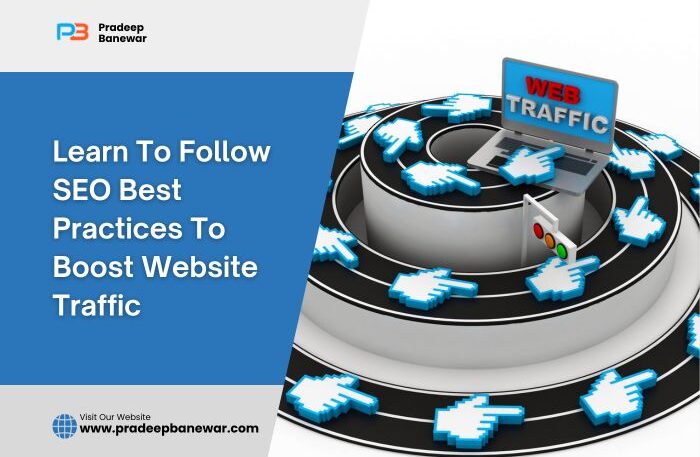Organic traffic is essential for websites in the constantly changing world of online presence. It’s not just a vanity metric; it is a crucial factor in long-term success because it shows how well your digital strategies work and how well your content connects with users.
As search engines improve their algorithms, getting more organic traffic has become an art and science.
This blog post explores the fundamental tactics required to increase website traffic organically—those time-tested techniques that withstand fads and algorithmic changes.
We’ll unpack a comprehensive guide to increase the visibility of your website, covering everything from the fundamentals of producing high-quality content and on-page SEO optimization to the nuances of mobile responsiveness and the influence of social media engagement.
Discover the specifics of keyword research, explore guest blogging and backlink building, and discover the importance of website speed and performance, which will help to increase website traffic organically.
You’ll gain a road map to boost your organic traffic and establish a sustainable and growing digital presence as we break down these ten effective techniques, supported by insights from current SEO trends.
Let’s set out with an objective to discover the secrets of organic traffic growth, giving your website the tools it needs to survive and thrive in the highly competitive digital landscape.
1. High-Quality Content Creation
The foundation of an effective online presence is high-quality content, which increases user engagement, builds brand credibility and impacts search engine rankings.
It involves a blend of relevance, depth, and connection with the target audience and goes beyond simple textual coherence.
Search engines prioritize content that benefits users in the world of SEO. Therefore, creating content that informs, entertains, or resolves an issue becomes crucial.
Utilizing multimedia components, such as attractive images, videos, and infographics, improves user experience and makes a piece more complete and shareable.
Search engine visibility depends on the seamless placement of keywords in your content. But the time of keyword stuffing is long gone, and user intent is now the primary concern.
An in-depth analysis of user needs and related content alignment ensures visibility and long-term audience interest.

Furthermore, shareable content is of a high quality. Social media algorithms and user behavior reward relatable content, increasing reach and brand exposure. Producing high-quality content becomes a strategic investment, a holistic approach that not only pleases search engines but also builds a following of devoted readers and positions your brand as an authority in your niche.
2. On-Page SEO Optimization
The foundation of a website’s visibility in search engine results, directly affecting its rank and visibility, is on-page SEO optimization.
It includes an attentive series of procedures that adjust individual web pages according to user expectations and search engine algorithms.
On-page SEO heavily relies on title tags, meta descriptions, and header tags, and all these help to increase website traffic organically. Avoid any common SEO mistakes while doing On-Page SEO.
Writing catchy titles that capture the main point of the content, informative and clear meta descriptions, and properly structured header tags improves user experience while helping search engines understand your content.
Another critical factor is the URL structure. A neat, well-structured URL with relevant keywords helps with user navigation and SEO. It’s a minute but significant detail that can impact click-through rates.

The placement of keywords strategically within the content requires subtlety that leads to an increase in website traffic organically. The focus is on natural integration that supports the overall narrative rather than keyword stuffing.
Google is regularly updating its algorithms and now prioritizes content that responds to user queries.
Creating a seamless, user-friendly experience while communicating with search engines about the relevance of the content is ultimately the goal of on-page SEO optimization.
Keeping up with these on-page SEO best practices is essential for enhancing and maintaining your website’s search engine rankings as search algorithms change.
3. Keyword Research and Targeting
Keyword research and targeting are fundamental to effective search engine optimization (SEO), which helps users explore digital channels to find content.
It is necessary to understand user intent in this complex process. By matching website content to these specific needs, advanced tools help identify the terms and details users use when looking for information.
Exploring both long-tail and short-tail keywords is necessary for effective keyword research. Long-tail keywords provide accuracy, catering to users with specific intentions, while short-tail keywords capture general search queries.
An increase in a website’s visibility across various search contexts results from striking a balance between the two.
User intent analysis is a crucial component of modern SEO and it goes beyond simply identifying keywords.
It requires figuring out the motivation behind a user’s search to produce content containing appropriate search terms to meet the user’s requirements.

It takes flexibility to implement a dynamic keyword strategy that helps to increase website traffic organically.
In today’s highly competitive digital environment, staying relevant necessitates reevaluating and updating keyword choices in response to changing user behavior and industry trends.
Essentially, keyword research and targeting are ongoing, strategic processes that change in response to user behavior and search engine algorithms, providing a dynamic roadmap for improving a website’s visibility and importance.
4. Mobile Optimization
Mobile optimization has grown from a suggested practice to a strict requirement in the world of technology.
Search engines like Google prioritize mobile-friendly websites due to the rise in mobile users, and they view mobile responsiveness as a crucial factor in search rankings.
Delivering a good user experience across multiple devices, especially smartphones and tablets, is the significance of mobile optimization.
It involves responsive design components that adjust to various screen sizes to keep the content accessible and visually appealing.
Google’s mobile-first indexing emphasizes how critical it is to prioritize mobile-friendly websites when indexing and ranking.
Mobile-unfriendly websites may rank lower, reducing their overall visibility and organic traffic.

On mobile devices, user expectations for speed are high. Mobile optimization involves improving images, browser caching, and coding techniques to increase website traffic organically.
An easy, straightforward mobile experience satisfies visitors and benefits search engine algorithms.
A website’s success depends on mobile optimization. In addition to meeting the needs of the expanding mobile user base, it also complies with search engine preferences, making a significant contribution to improved search rankings, increased user satisfaction, and overall success in digital media.
5. Social Media Engagement
With social media engagement, brands now have an engaging way to connect with their audience.
It became a cornerstone of modern digital marketing. Engagement on social media encourages a sense of community and brand loyalty beyond just sharing content.
A key component of social media engagement is producing shareable content. It involves writing blog posts that speak to the audience’s interests, elicit positive feelings, or add value.
Shareable content increases reach and exposes the brand to new audiences.
Must Read: Why Enroll in a Social Media Marketing Course: Benefits and Advantages

Building a social media presence requires conversations with followers. Engaging in conversations, responding to messages, and participating in comments humanizes the brand and builds trust.
The strategic application of trends and hashtags improves visibility. Trending topics help connect the brand with current conversations, and carefully selected hashtags organize content to make it easier to find users interested in particular subjects.
Additionally, social media algorithms encourage engagement. A brand’s content will show up in users’ feeds more frequently the more frequently they interact with it.
It highlights the value of encouraging two-way communication instead of a one-sided broadcast.
Social media engagement is an integrated approach that includes content creation, sincere engagement, and sensible platform feature use.
It also indirectly helps to increase website traffic organically. It increases reach and creates deep connections with a different and interested audience.
6. Guest Blogging
A powerful tactic in the digital marketing toolbox, guest blogging encourages cooperation between content producers and reliable platforms.
Beyond just spreading content, it’s a mutually beneficial relationship where both parties gain from a wider audience, a more credible reputation, and better SEO.
Beyond diversified traffic, guest blogging has many advantages. Brands and individuals can position themselves as industry thought leaders by submitting high-quality content to websites with a relevant audience and a solid reputation.
Backlinks from these trustworthy websites send direct referral traffic to the contributor’s website, and they improve its SEO, increasing its visibility on search engine result pages.

Effective guest blogging requires thorough research to find platforms compatible with the contributor’s expertise. Securing opportunities requires developing strong pitches that show value to the host site audience.
The shared content must be insightful, unique, and tailored to the target audience of the host site while maintaining its tone and style.
Guest blogging continues to be a strategic method for boosting online presence as search engines place more value on high-quality backlinks and various content sources.
It is a collaborative effort that strengthens digital authority, encourages audience trust, and creates long-lasting connections within the online environment, not just a traffic-acquisition strategy.
7. Backlink Building
Obtaining links from other websites to your own is the foundation of backlink building, which tells search engines that your content is credible and relevant.
As online endorsements, quality backlinks increase a website’s visibility and authority in search engine result pages, which helps to increase website traffic organically.
Backlinks are significant because they play a big part in search engine rankings.
Due to the perception that backlinks are signs of reliable and valuable content, websites with multiple and high-quality backlink profiles may rank higher.
Relationship-building, outreach, and content creation are all components of successful backlink-building strategies. Reaching out to trustworthy websites in your niche and providing them with insightful content or links can lead to earned backlinks.
Collaboration with thought leaders, subject matter experts, and other websites expands the audience for and impact of your content and frequently results in the development of natural backlinks.

Quality rather than quantity, though, is the focus. Over a dozen of low-quality links, search engines favor authoritative, relevant links.
Penalties for unethical actions, such as buying links, highlight the significance of building organic backlinks as a sustainable and essential component of an all-encompassing SEO strategy.
8. Website Speed and Performance
Website performance and loading speed are essential factors that impact user experience and, ultimately, a website’s success.
A website that takes a long time to load can lose visitors and lower its position in search engine results in the digital age when attention spans are short.
Recognizing the link between quicker loading times and satisfying user experiences, Google has emphasized the significance of page speed as a ranking factor.
Speed improves user satisfaction and is essential for mobile optimization, where quick information access is crucial.

Image compression, browser caching, and effective code implementation are just a few techniques to optimize website speed. Compressed images have smaller file sizes, which leads to faster load times without losing quality.
Local storage of frequently used resources by browser caching eliminates the need for continuous downloads and speeds up later visits.
The speed of a website impacts conversion rates. According to studies, even a one-second delay can cause a noticeable decline in conversions. It emphasizes how speed affects a website’s bottom line and highlights the importance of a company’s overall success.
Businesses that want to succeed in the online environment must prioritize optimizing website speed and performance.
It’s an investment that ultimately leads to business growth by increasing user satisfaction and search engine rankings.
9. Analytics and Monitoring
The foundation of data-driven decision-making in digital media is analytics and monitoring, which provide insights into user behavior, website performance, and the efficacy of online strategies.
A wealth of data is available from platforms like Google Analytics, including page views, user demographics, conversion rates, and traffic sources.
Setting up key performance indicators (KPIs) that align with corporate goals is required for effective analytics use.
Following these metrics over time enables one to identify areas for improvement, recognize trends, and fine-tune strategies for improved results.
For instance, monitoring bounce rates and user engagement helps to improve content strategies for a better user experience.

Continuous observation is essential for staying on top of developments. Regular data analysis enables businesses to adjust to users’ shifting preferences and behaviors.
It’s a dynamic process that guides general website optimization efforts, content creation strategies, and marketing choices.
Qualitative insights are equally valuable in addition to quantitative metrics. Comprehension of user interactions is possible thanks to user comments, heatmaps, and session recordings.
Businesses can efficiently customize their online presence to meet user expectations and market trends.
Analytics and monitoring are essential for determining future success in the constantly changing digital landscape, not just for tracking past performance. It makes it easier for businesses to pivot, improve, and succeed in the fiercely competitive online environment.
A comprehensive strategy is required to master the art of organic traffic growth in the dynamic world of online visibility.
Each element contributes to a website’s digital resonance, from the fundamental pillars of producing high-quality content and on-page SEO to the complexities of mobile optimization, social media engagement, and strategic backlink building.
Businesses can increase traffic and forge enduring relationships with their audience by using insightful analytics and a dedication to continuous improvement.
These strategies create a roadmap for increased visibility and long-term success in the digital ecosystem.





